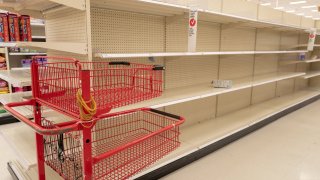
- Big retailers have sent mixed messages on the threat they face from retail theft.
- In January, Walgreens said it may have overstated concerns about theft and impact on retail "shrinkage," with its CFO James Kehoe telling analysts, “Maybe we cried too much last year."
- But in the more recent Home Depot and Target earnings for the just-finished quarter, both big-box companies cited a rising trend of retail theft and the industry is supporting the Combatting Organized Retail Crime Act to give the Department of Homeland Security more power to help.
It's been hard to get an exact read on the rise in retail theft. Best Buy sounded alarm bells back in November 2021 when it said thieves were traumatizing employees. Walgreens was vocal on the issue too, but then its chief financial officer James Kehohe did an about-face, telling analysts in January that the company may have overstated the issue and its impact on sales. “Maybe we cried too much last year," he said on the January earnings calls.
But this quarter's batch of retail earnings have brought the theft issue to the forefront again. Both Home Depot and Target cited rising retail theft.
Get Boston local news, weather forecasts, lifestyle and entertainment stories to your inbox. Sign up for NBC Boston’s newsletters.
"The country has a retail theft problem," Home Depot CFO Richard McPhail said on a call with CNBC on Tuesday after its earnings. "We're confident in our ability to mitigate and blunt that pressure, but that pressure certainly exists out there."
Home Depot's vice president of asset protection had told CNBC in March crime is increasing at double-digit rates.
Target said organized retail crime will reach $500 million more in stolen and lost merchandise this year compared with a year ago. On its earnings call, Target CEO Brian Cornell said retail theft is "a worsening trend that emerged last year."
Money Report
If the threat is moving in severity from one retailer to another, the industry remains convinced it has the numbers to say the crime trend is rising, and that this is not a shoplifting issue reflecting tougher economic times for Americans but increasingly the work of organized retail crime networks.
The National Retail Federation says organized retail crime is the main reason for retail "shrink" — a mismatch between actual inventory and what is on the books — which reached $94.5 billion in 2021, an increase of almost $4 billion year over year.
Its president Matt Shay told CNBC on Thursday that the issue isn't going away. "Conversations we've had with members over the last several years indicate it is getting to be a really acute and serious problem," and as far as the annual numbers, remains "growing."
While theft is "manifesting itself in stores with acts of violence," Shay stressed that in-store, individual crime is not the biggest scope of the problem. "It's not people shoplifting an individual item for personal use," he said.
But shoplifting is a big part of organized crime. Target chief financial officer Michael Fiddelke had said after its earnings in November 2022 that shoplifting jumped about 50% year over and year, resulting in over $400 million in losses in the fiscal year, and Walmart's CEO Doug McMillon issued another warning about the rising threat on CNBC in December.
"This is very sophisticated local, state, national and transnational organizations, organized not just to steal at the store level, but throughout the entire supply chain ... on the docks, on trucks, off ships, through containers, on the railways. This is a really persistent problem and it's across the supply chain," Shay told CNBC on Thursday.
That matches CargoNet data recently provided to CNBC by insurance company Travelers, which has a special investigations group and works with law enforcement to recover stolen goods. It found food and beverage coming into port or in a warehouse is No. 1 on the list of products being targeted by freight thieves who are increasing their criminal activity across the national supply chain, with household goods and electronics still high on the list of cargo thieves.
Physical theft is still the No. 1 method used by thieves in the supply chain, but they are getting more sophisticated, creating fictitious pickups through use of identity theft — pretending to be trucking companies, including infiltrating online freight management systems and freight brokerage phone lines.
"A lot of times, they will get away with it," Scott Cornell, transportation lead and crime and theft specialist at insurance provider Travelers, recently told CNBC. It has tracked a 600% increase in this form of cargo crime.
Cargo theft is occurring at multiple points in an item's journey, with the NRF finding that theft "en route from distribution centers to stores" was the top target, at 47.4%; followed by cargo theft at stores, at 42.1%, and cargo "en route from manufacturers to distribution centers," at 35.1%.
While the losses have gone up in total dollar amounts, years 2020 and 2021 were also a boom time for retail sales fueled by the pandemic stimulus and other Covid-related factors. In fact, the NRF data shows that the median and average amount of retail shrinkage hasn't changed much in recent years. The average inventory shrink of 1.4% in 2021 was the same in 2016; the median inventory shrink of 1.2% in 2022 was the same in 2016. And it's been at a similar level in all of the years in between.
Retailers surveyed by the NRF do attribute the greatest portion of shrink (37%) to external theft, including organized retail crime. And even though organized retail crime is the biggest component in theft, retailers surveyed do say violence against workers has risen even more. Over thee-quarters (77.6%) say guest-on-associate violence has increased in the past five years, compared to 70.7% saying organized retail crime has increased. Notably, no retailers surveyed by the NRF said organized retail crime has decreased.
The Walgreens CFO said in January that after spending a "fair amount" on private security companies, the results were "largely ineffective."
"We've put in incremental security in the stores in the first quarter. Actually, probably we put in too much. We might step back a little bit from that," Kehoe said.
But the majority of retailers (just under 70%), as of the 2022 NRF data, said they do not have an organized retail crime team in place. This staffing issue contributes to the issue of accurately tracking the theft. Retailers with a dedicated organized retail crime response team were almost twice as likely to report an increase as those without an in-house ORC team, the NRF found.
The National Retail Federation is lobbying for the Combatting Organized Retail Crime Act, which would create a function within the Department of Homeland Security to elevate the theft issue to "a national issue," Shay said.
It would allow the Department of Homeland Security to coordinate with law enforcement across the country, provide resources, and report to Congress.
"If this were a retail problem exclusively, retail would have solved it by now," Shay said.






